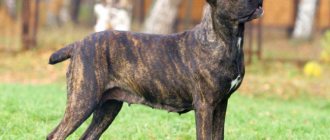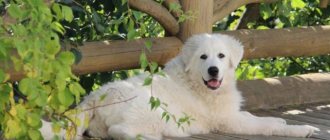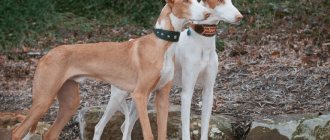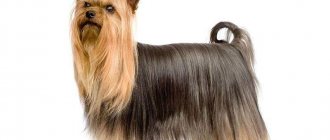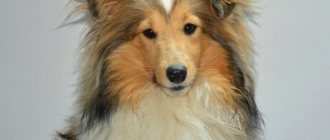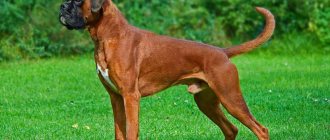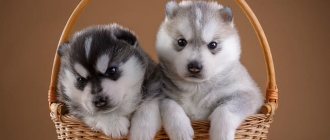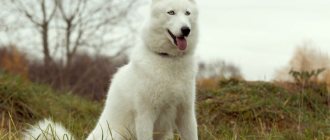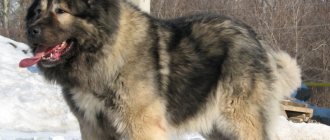If there is a need to get a dog in order to protect property or protect against hooligans, then you should pay attention to the Dogue de Bordeaux. This is an ideal guard and a wonderful companion. He is strong, beautiful and powerful. It's not scary with him. He will always protect his owners. Security qualities are passed on genetically from generation to generation. At the same time, he is calm and loves his owners and their children very much. He can follow them from room to room all day, keeping order. The Dogue de Bordeaux is excellent for training. This breed is interesting and certainly worthy of attention.
Description and characteristics
The Dogue de Bordeaux or French Mastiff (as it is also called) is the oldest breed of dog, the roots of which stretch to France. This is an excellent guard dog, which, despite its threatening appearance, can be affectionate and friendly. He is very affectionate to his owners and patient with children.
Because of its appearance, many people think that the Dogue de Bordeaux is an aggressive animal, but this is far from the case. This is a very smart and sensible dog: without sensing a threat, it will never give a voice, and if it senses danger, it will never attack without warning.
Aggressiveness
In the distant past, it was a fighting dog that was able to show its aggressiveness in exhibition fights or in relation to other animals. However, it is not aggressive towards humans: it will not attack anyone without a reason.
Activity
Bordeaux are not particularly active or playful. They prefer convenience and comfort. For an adult, it is enough to take a walk in the fresh air twice a day with a minimum amount of dynamic games.
Training
Often these dogs are very stubborn, and at any opportunity (actions that are performed against their will) they can show their character. A person training this breed of dog must have tenacity, strength and intelligence. If this is your first time acquiring such a dog and you do not have such character traits, then it is best to contact a professional trainer.
Shedding
The Great Dane has short hair, so when shedding it does not cause much trouble. The dog sheds its old fur in the spring. At this time, it needs to be combed more often than usual.
Need for care
Like all dogs, Great Danes need not only warmth and care, but also proper care. He needs to be bathed regularly, his teeth brushed and his ears checked for dirt. There are many folds on the body and face of this breed, the cleanliness of which must be monitored. The Great Dane's face needs to be washed regularly.
Friendliness and attitude towards children
The Dogue de Bordeaux treats children differently depending on how they are raised, but generally they are patient and friendly. Can tolerate even minor pranks.
Read What is good about a bobtail dog: a detailed description of the Old English Sheepdog
Health
Great Danes are distinguished by excellent health and good immunity. Therefore, it is quite enough to take a healthy dog to see a veterinarian once a year.
Attitude towards loneliness
The Dogue de Bordeaux is very attached to his home and owners, so a long separation can be very painful for him.
Maintenance cost
Owning a large dog is not a cheap pleasure. The body weight of an adult dog is 50 kg. The dog's diet must include beef trimmings, moss, sea fish, fermented milk products and cereals. While the puppy is growing up, it must be fed cottage cheese and eggs. None of these products are cheap.
Intelligence
This is a very smart dog. She easily distinguishes her own from strangers. You won’t just bark and attack someone. The dog also has well-developed intuition and intelligence.
Noise
Dogs of this breed have a very low noise threshold. However, they breathe quite loudly.
Security qualities
The Dogue de Bordeaux is an impeccable guard and protector. One look from him can cause fear in an ill-wisher. If necessary, he will immediately enter into battle and fight to the end. This large, muscular dog has been an ideal fighter, hunter and guard throughout the history of the breed. Previously, Bordeaux guarded military camps, farms and took part in exhibition battles.
Lifespan
French Mastiffs typically live 5-8 years.
Brief historical background
Dogues de Bordeaux are considered a very ancient breed of dog, but the history of their origin is very confusing and foggy. It is still unclear who exactly is the progenitor of these large dogs. There are three versions of the development of events. According to one theory, their genotype is directly related to the Tibetan mastiffs. The second version attributes the right of “paternity” to bulldogs. The third, most popular, option claims that the Great Danes inherited their unique appearance from the ancient fighting Alans - huge Molossian dogs who lived in the territory of today's Albania (ancient Molossia) about five centuries BC. However, no reliable facts confirming any of the theories have yet been discovered.
Alano fighting dogs are considered the ancestors of the Dogue de Bordeaux.
The first documentary evidence of French dogs of this type dates back to the 14th century. The work of the medieval writer and enthusiastic hunter Gaston de Foix, entitled “The Book of Hunting,” describes in some detail not only the appearance, but also the character of the Alanos, who were used for baiting large game and guarding cattle (and skinned carcasses during transportation), and also to participate in bloody dog fights.
The beginning of the modern history of French mastiffs can be considered the first dog exhibition held in the Paris Botanical Garden (1863) . It featured a red molossoid type dog named Magent, who received a gold medal and an honorable first place. Since the male was from Bordeaux, the name Dogue de Bordeaux was assigned to the breed.
Official breeding work began in 1892; already in 1896 the first breed standard was approved, which was later modified several times. The Dogue de Bordeaux received international recognition from the FCI in 1971. In the register of the International Canine Federation he is included in the second group - pinschers and schnauzers (section 2 - dogs of the Molosser and Mastiff type) under number 116.
The latest current and currently valid standard dates back to January 23, 2009.
Story
There are several theories about the origin of the Dogue de Bordeaux. According to the most common theory, they originated from French fighting dogs, inheriting their appearance from the Alans, large ancient dogs widespread in the 14th century in Spain and France. This animal had an iron grip, so they were bred for the purpose of herding wild animals, guarding livestock, shipping and dog fighting.
Health
Let us immediately note that the life expectancy of these large beautiful dogs usually does not exceed ten years. In general, they are in good health, but, like any living organisms, they are prone to various diseases.
Most often, French Mastiffs are diagnosed with joint problems. They are prone to skeletal growth abnormalities and arthritis. They also often experience flatulence, cardiovascular problems, lymphoma, cancer, hyperkeratosis, gastric volvulus, epilepsy, kidney failure, ear infections and heat intolerance.
Appearance
It’s not for nothing that the Dogue de Bordeaux is a good guard. After all, just the sight of it can scare a robber. This is a massive and rough dog that inherited its ferocious appearance from its ancestors. According to standards, the weight of a male should be at least 50 kilograms, and his height should be 61-69 centimeters. The bitch has slightly different indicators. Body weight ranges from 45 to 50 kilograms. Height is approximately 58-66 centimeters. With a rationally designed menu, a Dogue de Bordeaux puppy gains body weight quite quickly.
Head
When examining the animal from the front, it seems that its head is square. If you look at the dog from above, a trapezoidal shape clearly emerges. The large convex forehead is slightly longer than the muzzle. In the center of the forehead there is a small depression, from which folds stretch downwards, diverging on both sides of the nose. The Bordeaux mask is slightly darker than the main color of the dog. The head of the Great Dane is quite massive, and the muzzle with folds has a terrifying appearance.
Eyes
This breed of dog has brown or hazel eyes, oval in shape. They are planted quite low.
Ears
Compared to the Great Dane's body, its ears are medium in size. When at rest, the tips of the ear are neatly rounded and hang forward; when tense, they rise or lie close to the muzzle.
Jaws
The lower part of the jaw apparatus of this type of dog protrudes more forward than the upper. Characterized by the presence of a snack.
Read Briard - a dog whose eyes are covered with fur
Torso
The dog is large in build, but the back is short, wide and muscular. The dog's withers are elevated and the shoulder blades are tightly pressed.
Neck
The Dogue de Bordeaux has a short, muscular neck that flows smoothly into the shoulders. The head and neck are separated by a smooth fold.
Tail
This breed has a thick and strong tail, which tapers at the end. At rest, the tail is lowered; during active movements, it rises approximately 100°.
Paws
The forelimbs have elastic pads. The dog's paws are strong, with strong nails that need to be trimmed regularly. The hind limbs are slightly longer and set slightly closer than the forelimbs. They also have strong nails.
Wool
This breed of dog has short but thick hair that fits tightly to the skin. There is no undercoat.
Color
The Dogue de Bordeaux's coat is monochromatic and brown. The mask is slightly darker, black or missing. The nose is light, red or pink.
Dietary recommendations
Like any other dog, the Dogue de Bordeaux can eat both industrial and natural food. In the first case, it is preferable to purchase super-premium or canvas-class products produced by trusted manufacturers with a good reputation. This dry food contains not only nutrients, but also the entire range of vitamins and minerals necessary for normal growth and proper formation of the dog’s body.
Those who decide to feed their French Mastiff natural food should remember that the basis of the dog’s menu should be meat. It could be beef, lamb or poultry. Also, the dog should regularly be given raw, low-fat sea fish and offal, including liver, heart, kidneys and tripe. All this should be frozen for several days or scalded with boiling water.
Vegetables and fruits are considered an equally important component of the dog’s menu. For these purposes, pumpkin, carrots, zucchini, sweet bell peppers and apples are best suited. In addition, it is advisable to systematically give the dog kefir, yogurt, low-fat cottage cheese and boiled eggs. As for cereals, Dogues de Bordeaux do not need them too much. But if desired, they can be cooked from buckwheat, rice or oatmeal.
These dogs should not be fed chocolate, fried, salted, smoked or spicy foods. It is strictly forbidden to give them tubular bones, sweets, river fish and leftovers from the master's table. This kind of feeding can cause serious health problems for your pet.
Character
This dog is a very loyal friend and companion. He will always follow you, from room to room, and even on the street without a leash. These “evil” guards are completely harmless to loved ones, they can even get along with children. They endure separation from their owner very tragically.
Bordeaux cats love calm and balanced people, so they will be perfect for you if you are one. Great Danes also get along well with other family members living in the house and with pets, provided that they grew up with them.
Who is this dog suitable for?
Representatives of this breed require constant attention from the owner. They need regular physical and mental exercise. Therefore, their owners should be people who have enough free time. Plus, they should be able to provide their pet with quality nutrition, classes with an instructor, and regular veterinary care.
Since this dog is of impressive size, it will be cramped for him in a city apartment. Therefore, it is advisable to buy Dogues de Bordeaux only for those who live in a spacious private house with a large, fenced garden.
Maintenance and care
Keeping this dog requires certain costs, both for food and for providing proper care.
Nutrition
With a rationally designed menu, Dogue de Bordeaux does not gain excess weight. The basis of his diet should be lean meat, mainly beef. From time to time, meat can be replaced with offal, seafood or fermented milk products. Fruits and vegetables will be useful.
The Dogue de Bordeaux's diet should not contain the following foods:
- fish caught in the river and canned food from it;
- citrus fruits;
- raw and heat-treated mushrooms;
- beans, lentils and other legumes;
- small and hollow bones;
- baking from yeast dough;
- potatoes;
- dishes seasoned with garlic and onions;
- chicken;
- cakes and other confectionery products.
There should always be filtered or raw water in the bowl.
Hygiene
After eating or drinking water, you need to wipe the wrinkles on the face.
It is advisable to inspect the Dogue de Bordeaux's ears every day. Cleaning them once a week is enough.
You should clean the cover of your four-legged friend 2-4 times a month. This must be done using a brush or a special silicone glove. The dog's surface should be treated with antiparasitic agents no more than once a month.
Antihelminthic drugs must be given to animals as needed, and for preventive purposes - no more than once every six months.
Claws with burrs need to be trimmed once a month.
Health and illness
And although the Dogue de Bordeaux is the owner of excellent health, some diseases are not alien to him:
- dysplasia of large joints;
- arthritis;
- oncological;
- respiratory viral;
- volvulus;
- jades;
- nephrosis;
- congestive cardiomyopathy;
- hyperkeratosis.
Also, childbirth is often difficult, which is due to the size of the newborn’s head.
Read Boxer - a dog that is not suitable for everyone
Mating
Already at the age of 20-24 months, the female Dogue de Bordeaux is ready for mating. If the bitch, when touching the croup, moves her tail and spreads her paws wide, then this means that she is ready for fertilization. The 12-13 days of estrus are considered the most effective for mating.
Walks
A small representative of the breed can be walked for 15 minutes several times a day, gradually increasing the duration of the walk. Already at the age of 8-10 months, when the puppy’s tendons and ligaments become stronger, the growing pet can be walked for 30 minutes. The duration of stay on the street is increased due to the frequency of walks. An adult dog is usually walked for 30-40 minutes twice a day.
Dogue de Bordeaux diseases
A significant breed disadvantage noted by owners is the short life expectancy of Dogue de Bordeaux . Usually it does not exceed 8–10 years, only some centenarians live up to 12 years. French mastiffs are not burdened with any breed-specific hereditary pathologies. Problems of the musculoskeletal system that sometimes occur (joint dysplasia, dislocation of the kneecap, etc.) are caused by maintenance errors and unbalanced nutrition. There are difficulties with natural childbirth in bitches with a narrow pelvis. Because puppies typically have large heads, making it difficult for them to pass through the birth canal, an emergency caesarean section may be required.
Bordeaux, like all brachycephalics, has breathing problems associated with a narrowing of the larynx, nostrils, overgrowth of the soft palate and other defects. In this case, surgery may be required.
Training and education
There is no need to subject the Dogue de Bordeaux to special training. He was originally cultivated as a fighting and guard dog, so a guard instinct was inherent in him from birth. First, he must be taught to distinguish friend from foe by teaching the commands “friend” and “foe.” The “stranger” command will help develop the dog’s instinct not to take food from someone else’s hands. Puppy training should begin at three weeks of age, when he is particularly obedient.
It is advisable that the dog be raised by a man who has a strong character and good willpower. The main thing is that from the very beginning the Great Dane learns one immutable truth: he is not the leader in the family. Then you will be able to get an obedient, balanced and intelligent dog.
Peculiarities
Diseases
- The most common problem is hip dysplasia . It has both genetic and social factors of occurrence. To reduce the spread of pathology, puppies should be x-rayed at the age of 12 months to check for dysplasia. In its absence, mating can be carried out.
- With improper nutrition, gastrointestinal pathologies may develop: pancreatitis, hepatopathy, enteropathy, gastritis, gastroenteritis and others.
- bursitis (an inflammatory disease of the synovial bursae of large joint joints of bones) are common in French mastiffs The elbow, knee and hip joints are most often affected.
- may develop in the metatarsal joints. This pathology appears when the joint is injured (bruises, dislocations, etc.), as well as when infection penetrates into the synovial bursa from another source (hematogenously). As a preventative measure, it is important to ensure that the animal suffers as little injury as possible.
- You should also carefully treat infectious processes in the dog’s body.
IMPORTANT . The absence of signs of femoral dysplasia during X-ray examination does not guarantee that dysplasia will not appear in the offspring.
Photo
Reviews
Marina: “When they gave my first-graders a dog, I was worried at first, because the breed is a fighting one. But our dog quickly got used to it, made friends with the twins and became their real protector. Now I calmly leave home on business, leaving my children under the reliable protection of Karat, and I don’t worry that the Great Dane will offend them.”
Olga: “Our mastiff Rex turned out to be a surprisingly friendly and calm dog, despite his terrifying appearance. He doesn’t bark over trifles, he simply ignores Vaska the cat. And with a child, a Great Dane is a perfect match, they play and sleep together.”
Yuri: “The French bulldog Nyusha was abandoned for 2 weeks - friends were going on vacation. The dog treated me with restraint, but not aggressively. The pet behaved melancholy - he missed his owners. The dog walked calmly, ate well, and swam with pleasure. When I gave it to the family where Nyusha lives, both of them shed tears as they said goodbye. Now I want to get myself a mastiff.”
How to choose a puppy
When planning to get a dog, you must first decide what class the puppy should be: show, breed or pet.
If you just need a pet, then a representative of the pet class is quite suitable. If you plan to take part in exhibitions, then you should purchase a puppy of the “show” category, which most closely matches the breed standard. Then you need to decide on the gender of the puppy you are purchasing, whether it will be a female or a male. Bitches are more obedient and calm, therefore they are easier to train than representatives of the opposite sex, who are more energetic and playful.
The puppy himself is moderately active and curious. The norm for a baby is considered to be well-fed, in which he can move dynamically. The eyes are bright, brownish in color. Ears and paws are medium in size.
Price
The French Mastiff is a fairly expensive breed. The dog is considered prestigious. There are nurseries in which such animals are bred in almost every capital of the CIS countries, including Moscow and Kyiv.
The minimum price for Dogue de Bordeaux in Russia for 2019 is 25 thousand rubles. But, for such a price you definitely won’t buy a high-breed puppy with a pedigree. To become the owner of a show-class dog that can be registered at exhibitions, you will have to pay twice as much, at least 50 thousand rubles.
Nicknames
After you have adopted a dog, the question arises of what to name it. The table shows some options for nicknames for boys and girls.
| For boys | For girls |
| Alex | Alba |
| Bodysuit | Sultana |
| Vasco | Jesse |
| Graph | Elsa |
| Jack | Jasmine |
| Magent | Kitty |
| Zack | Lucky |
| Leo | Matilda |
| Buffalo | Olivia |
| Nelson | Polly |
Cinema
In 1989, the cult film in the drama genre “Turner and Hooch” was shot, where one of the main roles was played by a French mastiff dog named Beasley. After this film, the breed had a new wave of popularity.
